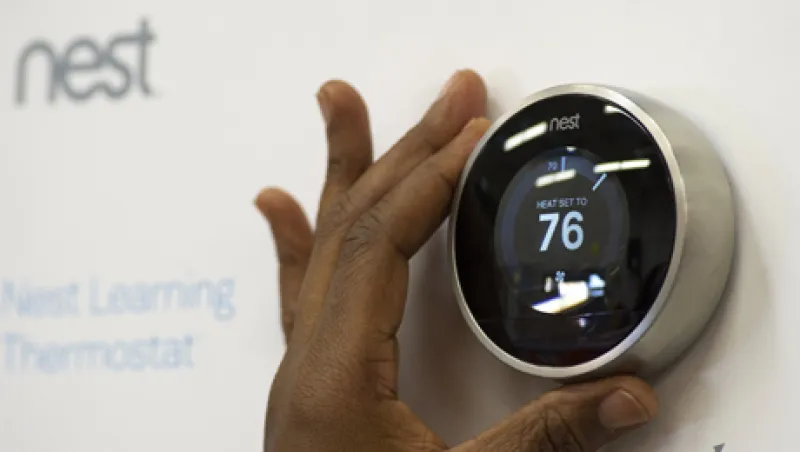Google’s recent purchase of Nest, a maker of Internet-connected thermostats and smoke detectors, for $3.2 billion in cash, spurred even more excited chatter about the rise of the “Internet of Things” — one of the most bandied-about tech expressions of 2013. A Forbes headline asked, “What Does Google’s Purchase of Nest Mean for the Internet of Things?” while the Guardian likely spent an entire morning in an editorial meeting to come up with “How Can Google Feather Its Nest with the Internet of Things?” But before someone might give a plausibly informed answer to those questions, it would be reasonable to first ask, What is the Internet of Things?
A simple, vivid example will do: In October former vice president Dick Cheney made a surprisingly technoconscious request. Turn off the Wi-Fi in my pacemaker, he told his doctors. Otherwise, someone might hack it and try to kill him.
Cheney is known for many things — Desert Storm, his ties to Halliburton, a spectacularly silly gun accident — safe to say, technological savvy is almost never listed among them. The former vice president was right to disable the Wi-Fi of his Internet-ready pacemaker, however. Two years earlier, Barnaby Jack — a New Zealand hacker known for his principled attempts to ferret out dangerously weak networks who died in 2013 of a drug overdose — had demonstrated on a conference stage that it was possible to control computer-equipped medical devices remotely. Anyone with a pacemaker with Wi-Fi capabilities intended to provide live updates on vital signs and other biological data might run the risk of having it hacked and disabled remotely, an effective and utterly silent means of murder. (An episode of the cable TV series Homeland made good use of the idea in its second season.)
As devices become smaller and smaller, they’re also becoming smarter and smarter: More and more of the objects with which we surround ourselves contain computers. I’ve mentioned wearable technology in a previous column; relevant in the Cheney instance, however, is that the small devices with which we interact minute to minute are increasingly linked by information networks that communicate without our interference, machine to machine.
Ever more of our everyday objects will think and learn all the time, without our oversight. Ingestible electronic pills will dispense intelligent dosages from inside a patient. A fireplace will not only turn on by itself but will also monitor the ambient temperature of your home — or your day-to-day natural gas consumption or the air quality in your neighborhood, to comply with local environmental regulations — and adjust the height of its flames automatically.
This interconnectivity of smart devices is the much-touted Internet of Things (IoT), already hailed as “changing everything” by outlets from the Harvard Business Review to Forbes. The latter cites a Wikibon study that IoT will become a $1.3 billion industry by 2015. The uproar over the innovation has been sustained, though it’s been hard to bat aside the buzzwords and get a sense of what’s really at stake for any number of markets or for the financial sector more generally as it surveys a shift ranked alongside the commercial use of drones and 3-D printing as a game changer.
Examples of IoT are easy to dream up; a smart fireplace or an electronic pill are in fact relatively unimaginative. All new forms of thinking things — from the practical (a credit card that destroys itself if separated from your wallet for more than two hours) to the whimsical (a minidrone that drifts above you on cloudy days and opens an umbrella over your head should it sense a drop of rain) — redistribute active human oversight away from day-to-day tasks. Less discussed is that the Internet of Things also involves a radical alteration of our conception of networked computers, that is, of the Internet itself. We’re used to thinking of the Internet as something we log on to from a screen, a network that lies waiting for us to switch on when we want. But the so-called client-server model is disappearing, taking with it many now calcified forms of industrial organization and outdated forms of data collection and business intelligence. Using the Industrial Internet, as General Electric calls its endeavors in thinking machinery, a company can, for instance, control its global supply chain by receiving up-to-the-minute updates from every link along the way, from raw resources to the sales floor.
Beyond the sales floor, too: Any object in the hands or on the feet or in the mouth of a consumer might become an accessible source of data. These are end-to-end disruptions in the way things are made and consumed. It’s not difficult to imagine an object — say, a toothbrush or a pair of sandals — that returns information to its manufacturer about how often and in what circumstances it is used, as well as its actual rate of obsolescence, all excellent indicators of future demand that don’t depend on the inaccuracies rife in consumer reporting. And if it’s not difficult to imagine that kind of network-ready, data-gathering thing, it almost certainly exists or is in prototyping. The Industrial Internet (the “intelligent machines” manufactured by GE and others, as well as the sensors and processors that make those machines so intelligent) has attracted investment from corporations that want to own the infrastructure that will handle the rich, interwoven wealth of data on the horizon — in some cases, already changing the organization of their businesses.
That means the emergence and rapid evolution of new markets (for sensors, for instance) and new opportunities to learn about existing ones. The more business owners and investors know — and the more traders know — the more sensitive and rapid the trades we make, and the closer we come to perfect arbitrage. The speed of low-latency information arbitrage will continue to increase as more and more objects are transformed into a fount of data. Developments around big data, statistical inference and multidimensional analysis continue to revolutionize trading and capital markets.
There is one pressing concern: the security of that data, and the hackability of the objects that transmit and collect it. Things that don’t or won’t need our permission to survey their environment and make decisions based on predefined parameters (Rain detected? Open umbrella) free us to think past our accustomed horizons. They also open a thousand new and dangerous doors. As the number of computers on any network multiply and diversify, so too do potential points of access to that network, past standard endpoints like desktops and smartphones.
Potential legal battles loom, between businesses and their consumers and between both parties and government. Multiplied is the amount of havoc hackers can wreak, as well as the unprecedented access surveillance, malware and other destructive activities might have to our bank accounts, our businesses, our bodies — that is, to every aspect of our lives. An ATM can be made to spew money, as was shown in another of Barnaby Jack’s demonstrations. It’s a frightening thought, one we’ll have to manage before the Internet of Things will make its way into the world.






